SHOP DRY EYE CARE TODAY!
Use code VISIONARYEYE20 at checkout for 20% off!
As parents, we all wish to see our children thrive and excel in every aspect of their lives, and ensuring they have optimal vision is a crucial part of their overall development and well-being. At Visionary Eye Center in Reno, we understand the importance of early detection in preventing and treating pediatric vision problems. This guide is designed to help parents spot the early warning signs of vision issues in children, emphasizing the critical role of pediatric eye exams.
One of the first indicators that a child may be experiencing vision problems is a noticeable increase in squinting, blinking, or eye rubbing. These actions can be a child's instinctive response to try to clear their vision or relieve discomfort caused by eye strain. Frequent squinting might suggest your child is struggling to see clearly at a distance, indicative of myopia (nearsightedness), while difficulty focusing on close objects might point towards hyperopia (farsightedness) or astigmatism. Recognizing these behaviors as potential signs of vision issues is the first step towards seeking a pediatric eye exam.
Eye rubbing, especially if it's persistent, could also indicate eye fatigue or irritation. While it's normal for anyone to rub their eyes occasionally, constant rubbing might suggest an underlying issue that warrants a professional evaluation.

Children who experience discomfort when performing tasks that require near vision, such as reading or playing with small toys, may start to avoid these activities. This avoidance can be a subtle sign of vision problems. Parents might notice their child feeling frustrated or showing a lack of interest in learning activities they previously enjoyed. If your child is avoiding homework, reading, or engaging in detailed play, it could be a sign that these tasks are visually challenging for them due to uncorrected vision issues.
Another common sign that can indicate a vision problem is when a child consistently holds reading materials or digital devices too close to their face or sits nearer to the television than is typical. This behavior may suggest that your child is trying to compensate for blurred distance vision, a hallmark symptom of myopia. While many children like to sit close to the TV for fun, if your child seems to need to sit close to see clearly, it's time to schedule an eye exam.
Listen closely if your child frequently complains of headaches or eye pain, particularly after reading, doing homework, or spending time on a computer or tablet. These complaints can often be attributed to eye strain resulting from uncorrected vision problems. A comprehensive pediatric eye exam can help determine whether vision issues are the cause of your child's discomfort, providing a path to relief through proper vision correction.
If you've noticed any of these signs in your child, it's important to take action by scheduling a pediatric eye exam. Early detection and treatment are key to ensuring your child's vision development is on track. Visionary Eye Center in Reno is here to support your family with comprehensive pediatric eye care services. We encourage parents to observe their child's visual behavior and seek professional advice when concerns arise.
Regular pediatric eye exams are a vital part of children's health care routine, helping to catch and correct vision issues early. Contact us today to schedule an exam and take the first step towards safeguarding your child's vision.
As parents, our children’s health is always a priority, especially when it comes to their vision. Identifying signs that may indicate the need for a pediatric eye exam Reno can make all the difference in ensuring your child’s eye health and supporting their overall development. Visionary Eye Center in Reno is committed to helping parents recognize these signs and understand the importance of regular eye exams for children.
Many children face challenges when it comes to reading or focusing on objects up close, but they might not always express it. You may notice your child squinting, holding books too close, or becoming frustrated with tasks that require near vision. These could be early signs of common vision problems such as myopia (nearsightedness) or hyperopia (farsightedness). Scheduling an eye exam in Reno early on can help detect any issues and provide timely interventions, which are important for your child’s academic success and well-being.
Additionally, if your child avoids activities that require detailed vision, like drawing or solving puzzles, this might indicate that they’re having trouble seeing clearly up close. Such behaviors highlight the need for an eye exam to ensure their vision is developing properly.

If your child frequently rubs their eyes or complains of discomfort in bright lights, these could be signs of eye strain or other vision problems. These symptoms often go unnoticed by parents, but they’re important indicators that an eye exam Reno may be needed. Regular pediatric eye exams can help detect any underlying conditions early, preventing long-term vision issues and supporting your child’s overall eye health.
If your child avoids tasks that require precise vision, such as reading small text or distinguishing between similar shapes, this could be a sign of an undiagnosed vision issue. These challenges may not just be a lack of interest but rather an indication that your child needs a thorough eye exam. Watching how your child performs in activities that demand visual accuracy can provide important clues about their eye health.
Frequent headaches or eye pain, especially after reading or engaging in visually intense activities, should not be overlooked. These symptoms often signal eye strain or other vision problems that require attention. Scheduling a pediatric eye exam in Reno can address these complaints early, preventing further discomfort and possible worsening of underlying conditions.
At Visionary Eye Center in Reno, we emphasize the importance of paying attention to your child’s vision. Regular eye exams for kids, even if they don’t show symptoms, play a key role in supporting their eye health and development. If you notice any of the signs listed above, don’t hesitate to schedule a pediatric eye exam near you. Our team is here to provide expert care and guidance for your child’s vision needs.
Early detection and treatment are essential for ensuring that your child’s vision supports their learning, growth, and happiness. Contact Visionary Eye Center for your eye exam in Reno and professional pediatric eye care tailored to your child’s unique needs.
Your eyes are windows to the world, but they can also be sources of discomfort and concern. In Reno, where the climate and lifestyle can impact eye health, understanding how to manage common eye problems is crucial. Visionary Eye Center, a leading group of Reno eye doctors, offers practical advice for dealing with issues like dry eyes, red eyes, and eye infections.

Dry eyes can result from environmental factors like Reno's dry air, certain medications, age-related changes, and prolonged contact lens use. Recognizable by a gritty feeling, burning sensation, and temporary blurred vision, dry eyes are more than just an annoyance.
Combatting dry eyes involves a combination of using lubricating eye drops and avoiding conditions that exacerbate the issue. Regular breaks from screen time, staying hydrated, and using a humidifier can also help.

Red eyes can stem from allergies, eye strain, or more serious conditions like infections. Keeping your hands clean, avoiding eye-straining activities, and using appropriate eye protection are key preventative steps.
For temporary relief, cool compresses and proper eyelid hygiene can be effective. However, persistent red eyes may indicate an underlying issue that requires professional attention.

Eye infections, caused by bacteria, viruses, or fungi, often present symptoms like redness, pain, discharge, and light sensitivity. Treatments vary but typically include medicated eye drops or ointments. For contact lens wearers, maintaining good hygiene is crucial for prevention.
Persistent, worsening, or severe symptoms warrant a visit to an eye care professional. Delaying proper care can lead to complications and should be avoided.
Persistent or severe eye problems should prompt a visit to an eye care professional. Self-diagnosis and treatment can delay effective care and potentially lead to complications. Visionary Eye Center in Reno offers expert care for various eye conditions and can provide tailored solutions for your eye health needs.
Age-related vision issues can affect anyone over time, and may not be apparent right away. Even if you haven’t experienced vision issues during your life, some conditions can begin to surface when you’re 40 or older. At Visionary Eye Center, our Reno optometrist recommends the following tips to preserve your eye health:
After you turn 40, it’s important to receive an eye exam every year. This helps to record and track any changes that may affect your vision. If you are experiencing any of the following symptoms, we recommend consulting an optometrist to mitigate risks and provide treatment where necessary:

Like it or not, you become more susceptible to vision issues as you age, and some can be debilitating. From dry eyes, to cataracts, to macular degeneration, an experienced eye doctor can diagnose and produce a treatment plan to suit you.
Dry eye is more debilitating as you age. While it may seem common in Northern Nevada thanks to our dry climate, there may be other factors contributing to the symptoms of burning, redness and tearing. As many as 3 million women and 1.7 million men over 50 in our country are affected by the syndrome.
How does dry eye occur? Tear film dysfunction has many causes, including computer use, contact lens wear, makeup, hormone changes associated with aging and autoimmune disorders, which further increase the risk of corneal scars or infections.
Optometrists also see numerous patients with cataracts, the leading cause of blindness in the world. Cataract symptoms include a decrease in visual clarity, foggy vision, glare, and halos of light. Cataract surgery is a simple outpatient surgery and the artificial lenses placed during it will last for the rest of your lifetime.
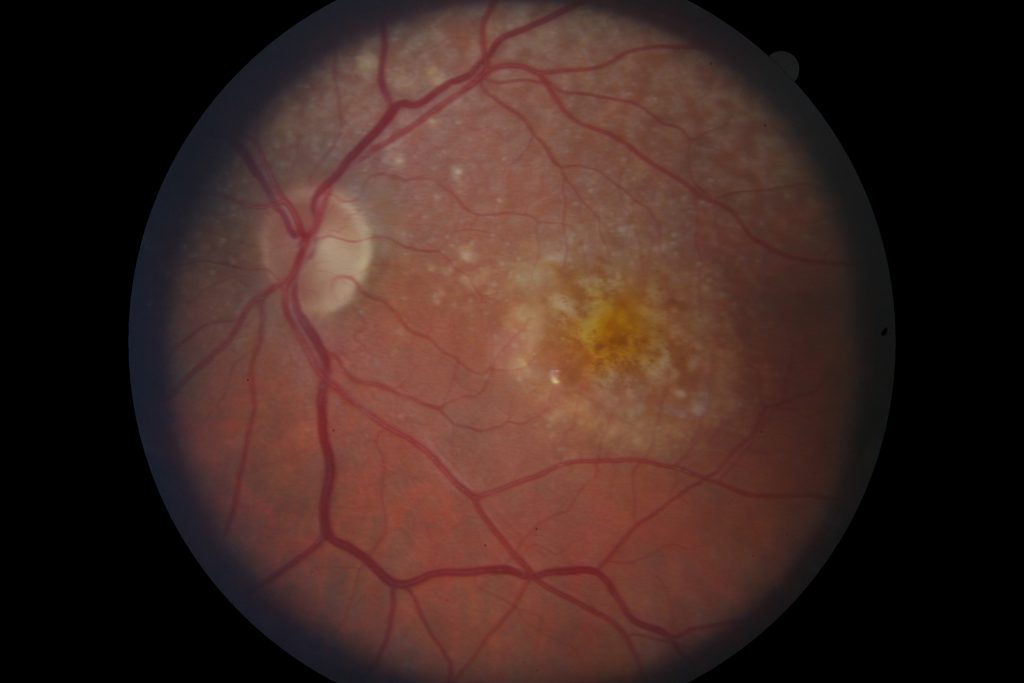
Retinal scan of dry macular degeneration
Lastly, macular degeneration is the primary culprit for blindness in adults over 50. While these patients never go completely blind from the condition alone, it certainly devastates their independence. There are two versions of macular degeneration: wet and dry. At Visionary Eye Care Center, we diagnose and manage both conditions with help from our local retinal specialists.
It turns out the advice of “don’t stare too long at the TV” is still true, thanks to our phones and other electronic devices. Recent studies show that we blink less than half as often when looking at a screen, which can lead to dryness and eye fatigue.
Our Reno family eye care experts suggest that everyone, at any age, should practice the 20-20-20 rule when using a screen. Just looking at something 20 feet away, for 20 seconds, every 20 minutes, will help reduce the dryness and eye strain of computer vision syndrome.
Using proper eye protection outdoors is also important. UV rays are harsh on your eyes in the long term. Sunglasses work wonders to protect your eyes from the elements and reduce your risks of cataracts, pterygia and macular degeneration.
Lastly, a balanced diet that is rich in Omega-3s, Vitamins C and E, and zinc, can help combat age-related eye disease. These supplements are often used to combat the effects of dry eye and slow the progression of dry macular degeneration.
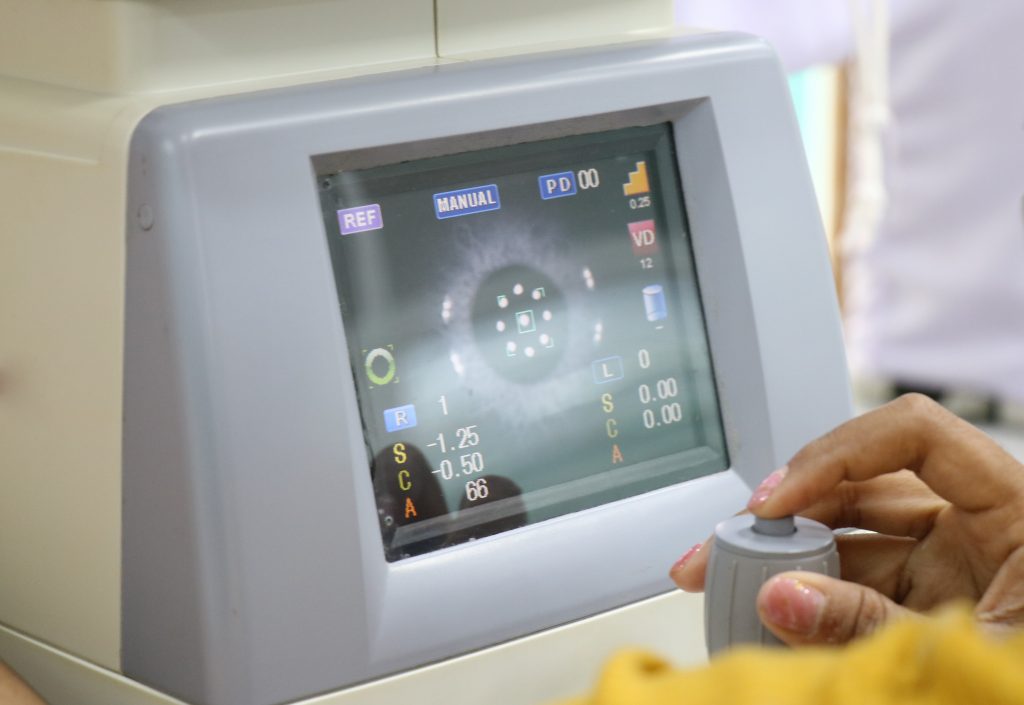
All in all, simple changes to your lifestyle and new habits will help prolong your eye health. If you’re experiencing changes in your vision or have questions about how to protect your eyes, make an appointment at our Reno optometrist office today.
Request an Appointment at Visionary Eye Center
It’s pretty painful to get a sunburn after missing a spot on your skin with sunscreen. Just imagine how a corneal sunburn would affect your quality of life during some of the best weather of the year. Also known as photokeratitis, this issue occurs during short-term exposure to high intensity UV-B rays. Photokeratitis is painful but temporary and is similar to a sunburn, but on your corneas (the clear portion of your eye in front of your pupil) instead of skin. It can look like a yellow, thickened area in the whites of your eyes. Too much exposure with ultraviolet rays can temporarily damage your conjunctiva, which is the clear layer of tissue covering the inside of your eyelid and whites of your eye.
Summertime activities that can put someone at increased risk for photokeratitis include mountain climbing, hiking, skiing, and swimming. It can also occur if you use sunlamps and tanning beds, or spend time in an environment with consistent UV light exposure.
There are two types of UV light proven to contribute to eye, skin, or health issues. UV-A rays can pass through your eye’s cornea to reach the lens and retina. UV-B rays can’t pass through glass but still can cause eye damage.

The symptoms of photokeratitis are pain and redness in the eyes, swelling, light sensitivity, headaches, temporary loss of vision, twitching eyelids, and seeing halos (like in the photo below). They can last from six to twenty-four hours but typically disappear after forty-eight hours.

Photokeratitis is most often formally diagnosed after an eye exam, and your doctor will place drops containing a special dye known as fluorescein in your eyes to reveal any superficial irregularities on the surface of your cornea. As for treatment, go indoors immediately after experiencing symptoms and avoid bright lights. Once in a darkened area, place a cold washcloth over your eyes and take ibuprofen. If you wear contact lenses, remove them and use artificial tears to reduce discomfort.
The longer you were exposed to UV lights, the more severe the symptoms. Long term exposure to even the tiniest amount of UV radiation can increase the risk of developing a cataract or macular degeneration (an eye disease that leads to vision loss in the center), or cause tissue elevations on the surface. These conditions are known as pinguecula and pterygium, but can be prevented by wearing sunglasses.
If you wear contacts, ask about ones that absorb UV rays when working or playing in a sunny environment. But even with these types of contacts it’s still important to wear protective sunglasses to shield your eyelids and conjunctiva from the suns’ rays.

The good news is that photokeratitis is preventable simply by wearing the proper eye protection when outside, like prescription sunglasses or snow goggles in the winter. Glare from snow, sand, or water can cause burns to your eyes even if it’s overcast. A wide brimmed hat can help filter out the sun’s rays as well.
When purchasing a pair of sunglasses, it’s worth noting that not all sunglasses are polarized. Polarized sunglasses are manufactured in a distinctive way that creates a different pattern in the lens to block out more light than a usual pair of sunglasses. When choosing a pair, look for one that provides one hundred percent UV protection or UV 400 protection. Prescription sunglasses help with overall light sensitivity, headaches caused by glare, and regular eye strain from squinting in bright sunlight.
For more information, check out our other blog post on prescription sunglasses here.
Be sure to visit your eye specialist once a year to stay up on your eye health and catch any issues early. It’s never been a better time to make an appointment with the team at Visionary Eye Center to get the perfect pair of prescription sunglasses for your summer adventures.
Our Reno eye care facility is one of the best in preventing photokeratitis in our patients.
Schedule an Exam with an Eye Doctor in Reno
As the school year comes to an end, it’s important to make sure that your child’s eye health remains on track during the summer and beyond. Younger generations are more susceptible to myopia, which is caused by the lengthening of the eye from front to back. Consequently, light is focused in front of the retina and not directly on it, causing distant objects to be blurry. The best way to prevent child myopia from developing or worsening is to get them in to see a Reno optometrist who will create a treatment plan designed specifically for their eye needs.
Myopia is prominent in children today because of environmental factors ranging from poor lighting and not enough time outdoors to excessive screen time. Genetics also can play a role based on if both parents or only one is myopic. A fifty percent chance of myopia is possible if both parents have it, a thirty-three percent chance if one parent has it, and a twenty-five percent chance if neither parent is myopic.
Children who spend at least two hours a day outside with sunglasses on are less likely to become myopic. However, researchers found that once a child has become nearsighted, outdoor time does not slow myopia progression.
Myopia can put an individual at risk for complications like retinal detachment, glaucoma, cataracts, chorioretinal degeneration, and more as they age. It is definitely considered an epidemic with a forty percent diagnosis rate in young patients and climbing.
Another increasingly common issue in children today is eye turns, or strabismus. Known as being “cross-eyed,” it’s the result of excessive focusing. Sometimes it is a genetic issue in children, and other times it can be developed between the ages of one year to four years. We can detect and treat both of these issues with vision therapy and surgical treatments, all while ensuring you or your child have the proper depth perception.
The MiSight 1-day program is FDA approved and helps optometrists across the country change the futures of young patients on the road to myopia. According to CooperVision, the corporation behind the high-quality contact lenses, age-appropriate children wearing MiSight experience an average of 59% reduction in myopia progression during a three-year period. There’s also a 52% reduction in eye lengthening, and more than 90% of children continued to express a strong preference for MiSight 1-day contact lenses over their glasses at the five-year check-up. Their parents expressed the same sentiment as well.
We typically recommend MiSight for lower levels of myopia (approximately -1.00 or less), over alternatives like Ortho K for myopia control. If you’d like to learn more about the efforts to educate people and prevent worsening side effects of myopia, check out CooperVision’s Facebook page and YouTube channel.
Over half of the country’s eye care practitioners agree that if myopia is left untreated, it will lead to irreversible vision loss. After some time, detrimental diseases like retinal detachment or myopic maculopathy are possible. MiSight lenses accommodate a more active lifestyle, provide and correct distance vision immediately, and are comfortable at any age.
As a pediatric optometrist in Reno NV, Visionary Eye Center has plenty of experience helping children and even their parents navigate the different tests and procedures for evaluating vision and eye health. Here is a quick rundown of what some of the most common machines we use to treat myopia while lessening its side effects over time:
One of the machines our practice utilizes is the Zeiss IOLMaster for axial length measurements, as it’s the best way to monitor myopia progression. This equipment for ocular biometry measures the size of the eyeball, originally designed to calculate the dioptric power of intraocular lenses implants (IOLs) for cataract surgery, but is now used by leading myopia control doctors to track the growth of the eye.

This is something that can be easily monitored in children because when the elongation progresses beyond 26 millimeters, the risk of potential vision impairment increases dramatically. Even better, this machine is quick and painless – we can measure both of a patient’s eyes in less than a minute!
Measuring axial length is a vital measurement when looking at treatment, as using prescription alone is too variable. Unfortunately, many doctors haven’t equipped their offices with the technology at this time– but we have it here at Visionary Eye Center, setting us apart as experts treating myopia at a higher level.
Measuring axial length is also the only way to track myopic elongation in orthokeratology. Orthokeratology, or Ortho-K, creates specially designed corneal molds to considerably reshape the eye overnight as part of an FDA-approved process for all ages. Similar to how dental braces can reshape your teeth, Ortho-K processes help fix those refractive errors that cause myopia or hyperopia and astigmatism as well.

Topography maps are taken using our Keratograph 5M and are used for fitting contacts like MiSight, as well as dry eye testing with the Crystal Tear Report. It’s an incredibly helpful tool for the diagnosis of and education about dry eye. As an advanced corneal topographer, the Keratograph can examine the meibomian glands in infrared imaging and evaluate the tear lipid layer. The Keratograph is effective in measuring the tear film break-up time and the tear meniscus height measurement in a non-invasive, painless way for patients.
The Maestro is used for the screening of glaucoma, cataracts, diabetic retinopathy, and macular degeneration. Taking a look at a patient’s retina, optic nerve, and anterior segment of the eye is a much quicker practice than before. Using Maestro technology allows our Reno optometrist to rapidly and clearly analyze various functions and facets of the eye for the most reliable results.

The team frequently relies on Pentacam technology to custom design gas permeable (GP) and scleral contact lenses. Gas permeable contacts are made of firm, durable polymers with high oxygen permeability. High oxygen permeability helps keep eyes healthy with orthokeratology for myopia control or scleral lenses. The Pentacam allows our Reno optometrists to create a 3D model of the front surface of the eye which can be used to design highly customized contact lenses.
All in all, we strive to have the best technology for our patients and the services and scans provide vast treatment options. If you’re struggling with myopia, dry eye, or the after-effects of either of these conditions, Dr. Jason Bolenbaker is here to help.

All in all, we strive to have the best technology for our patients and the services and scans provide vast treatment options. If you’re struggling with myopia, dry eye, or the after-effects of either of these conditions, Dr. Jason Bolenbaker is here to help.
The MiSight program is just one of the ways we reach our goals based on our philosophy of how an educated patient makes better health decisions for their families. We want our patients to be educated on every treatment option offered to them, and make the best choices for their care.
Our team of optometrists in Reno is ready to help patients of all ages begin their eyesight correction journey and prevent any further issues. Contact the Visionary Eye Center today and make an appointment with a medical care team you can trust.
Here at Visionary Eye Center, we treat plenty of patients with blepharitis, so you aren’t alone. An estimated 82 million Americans have been diagnosed with the eyelid disease. As eye doctors in Reno with decades of experience, we strive to make sure that our patients understand the cause of blepharitis: simply just an abundance of bacteria near the eyelids.
Because the disease contributes to dry eye syndrome, it leads to other symptoms like itching, a gritty feeling in the eyes, eyelid crusting that looks like dandruff, and red, swollen eyes. In addition to serious discomfort, blepharitis can negatively affect those scheduled or in the process for cataract or LASIK refractive surgeries. If left untreated, blepharitis can cause patients to experience chronic red-eyes, styes, or damage to their corneas.
There are two different types of blepharitis: posterior and anterior. Posterior blepharitis is usually caused by inflammatory conditions like rosacea. Anterior blepharitis is typically caused by microbes like Staphylococcus bacteria (which causes staph infections) and Demodex mites.
Demodex are mites that live on skin and thrive in hair and lash follicles. Younger children or the elderly are more likely to have an abundance of mites. Demodex mites’ average lifespan is estimated to be several weeks, but that is enough time to cause serious cases of blepharitis. They cause irritation with burrowing and laying eggs, and producing small amounts of waste products which feeds further bacterial growth.

Treatment for blepharitis is possible. One common option for Reno optometrists to utilize is ZEST, or Zocular Eyelid System Treatments. It works by gently exfoliating the eyelids to restore the natural state and cleans the eyelid margins to open up the meibomian gland. ZEST ensures the glands can release oils into the eye to create a healthy tear film and reduce symptoms of dry eye, all while providing thorough treatment for blepharitis and other potential diseases. This natural procedure is completed in about ten minutes and helps solve crusting around the eye.
Blepharitis can damage the meibomian glands along the edge of the eyelid where the eyelashes are. These glands create oil needed for tears. The oily layer is the outside of the tear that prevents them from drying too quickly. A number of eye issues can involve these glands, and for more information on additional treatments and procedures, head to our informational page on dry eye syndrome.
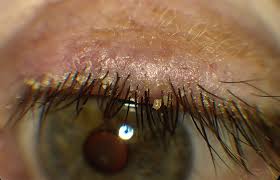
It is not too late to seek out treatment for Demodex mites on your lids or blepharitis. With a variety of eye care methods, including the use of ZEST, the team here at Visionary Eye Center can relieve your eye concerns. Book an appointment today with the best Reno optometrists in the city.
According to Dry Eye Directory, approximately 5-15% of the American population experiences dry eye syndrome. While the climate in Reno influences many to experience this disease year round, the winter months heighten symptoms for most Northern Nevadans. Nevada’s winter season leads to increased dryness due to decreased humidity in the atmosphere.
As an eye doctor in Reno we want to make sure that the Reno community is aware of two solutions we offer to help combat discomfort in the eye. If dry eyes are not properly addressed, you can experience inflammation in the eye which could damage its surface.

Our eyes produce tears to help maintain moisture and wash away any particles collected throughout the day that shouldn’t be there. This is crucial to prevent dry eyes, noting that Reno’s climate is not the only culprit influencing this issue. Someone may experience dry eye syndrome due to their body’s inability to produce tears properly or the quick evaporation of tears being produced.
People experience this problem due to unhealthy habits, older age, climate, smoking, the use of allergy medicine, and the use of contact lenses.
The Ocular Surface Disease Index Test helps us monitor your symptoms with the use of 20 scientifically validated questions. Feel free to take the quiz to help you understand the severity of your symptoms and help us when guiding you towards the most appropriate treatment.
THE OCULAR SURFACE DISEASE INDEX (PDF)
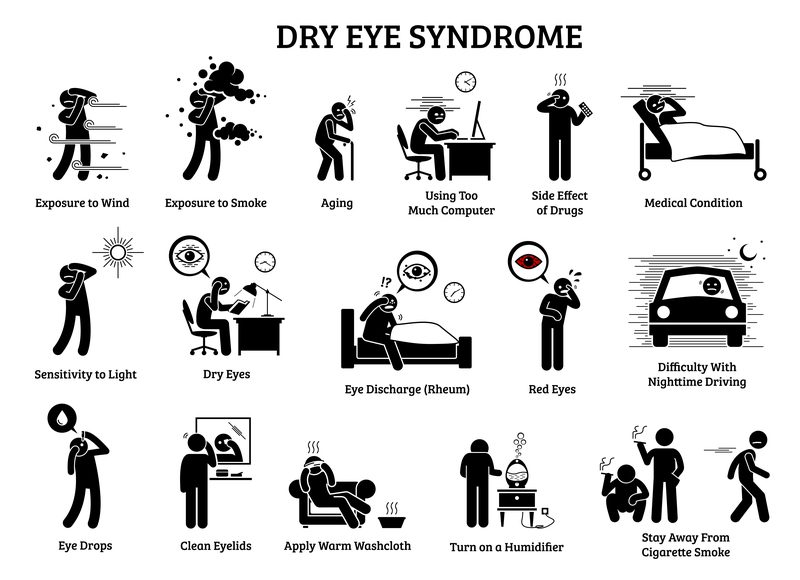 Dry Eye Syndrome leads to discomfort in the form of a stinging or burning sensation, a gritty feeling, dryness in the eyes, red eyes, and watery eyes. These symptoms can be a pain causing many individuals to become sensitive to light, experience increased eye fatigue, filmy vision, or difficulty wearing contacts. Using one of the many dry eyes treatments we offer can help combat challenges created when dealing with this common disease.
Dry Eye Syndrome leads to discomfort in the form of a stinging or burning sensation, a gritty feeling, dryness in the eyes, red eyes, and watery eyes. These symptoms can be a pain causing many individuals to become sensitive to light, experience increased eye fatigue, filmy vision, or difficulty wearing contacts. Using one of the many dry eyes treatments we offer can help combat challenges created when dealing with this common disease.
One of the latest treatments offered at our clinic is TearCare. This treatment applies heat to the eyelids using a tool that helps remedy meibomian gland dysfunction (MGD). This issue is commonly experienced due to clogged oil glands located near the edge of your eyelashes. These glands are important because they produce an oil layer for your tears to prevent them from drying out too quickly.
This procedure is a comfortable, wearable technology that applies gentle heat to the eyelids to liquify the meibomian allowing blockages to loosen. Once these blockages are cleared, you will experience improved production of the oils that help keep your eyes from getting dry. One benefit of this procedure is how quickly it can be done. The procedure is non-invasive and can be completed in minutes.
At the Visionary Eye Center we offer you another simple solution to help you solve and prevent dry eye disease. Zest (Zocular Eyelid System Treatment) focuses on exfoliating the eyelids to help return them to their natural state.This natural procedure is completed in about ten minutes and helps solve crusting around the eye associated with blepharitis, a condition caused by bacterial biofilm overgrowth.

By using this procedure, you can reduce your eye's collection of bacteria which causes dry eyes. Just like TearCare, this improves the outflow of the oils needed to prevent unfavorable symptoms from occurring by removing the film blocking the meibomian gland openings.
Now is a great time to take action and get rid of dry eyes fast. Whether you experience symptoms all year long or notice heightened sensitivity during the colder months, the Visionary Eye Center offers you a solution. With a variety of eye care methods and treatments, we can help you combat the many symptoms associated with dry eyes. We aim to provide custom eye care solutions for our patients in the Reno-Sparks area. Come visit us at the Visionary Eye Center and allow us to relieve your dry eye concerns.
Keratoconus may not be a familiar word for many people, but the disease affects a large number of eye care patients. Keratoconus (KCN) is a progressive eye disease that causes complications with the cornea. It results in vision problems that range from mild to severe and will likely require some form of corrective methods to improve the person’s ability to see.
Through years of research, professionals have been able to determine generally how many people have keratoconus, and the results are surprising. Since a 2017 study performed by Dr. Daniel Godefrooij, it was found that KCN affects roughly 5-10 times more patients than the original findings suggested. Let’s take a deeper dive into what keratoconus is below.

As stated above, keratoconus is a progressive eye disease that can impair a person’s vision and significantly affect the cornea. For patients with keratoconus, the cornea in one or both eyes becomes thin and scars in the center. Specifically, keratoconus involves the central portion of the cornea, which affects a large portion of the eye. The result is a noticeably protruding cornea that has an irregular conical shape followed by poor eyesight.
It’s typical for keratoconus to become present during puberty, or a person’s teen years, and worsens or progresses over time. By the 5th or 6th decade of life the disease will stabilize, but typically a patient with keratoconus will experience irregular astigmatism or scarring that might not be treatable by corrective lenses alone. In the worst cases, a patient may require a corrective procedure known as a corneal transplant.
Originally, research done in part by NKCF (National Keratoconus Foundation) suggested that 1 in 2,000 people were diagnosed with KCN. Years later in 2017, these numbers were questioned by Dr. Daniel Godefrooij who determined that these rates are significantly higher than what was traditionally found. When determining how many people have keratoconus, LASIK (laser in situ keratomileuses) eye surgery played a critical role.
LASIK is a popular method of vision correction that uses lasers to correct the refraction of eye lenses for patients suffering from myopia, hyperopia, and astigmatism. With the increased popularity of LASIK therapy came the realization that keratoconus affects more people than had been previously reported.
Today, Dr. Daniel Godefrooij reports the ratio of people suffering from KCN being 1 in 375. That’s more than 5 times as many people as researchers had originally found.
The cause of KCN is still mostly undetermined, but the development and progression of the disease have been heavily studied over time. Some research has suggested that chronic rubbing of the eyes may contribute to and possibly expedite the overall progression of the eye disease. The most common symptoms of keratoconus to be aware of include:
The plan of treatment for keratoconus will depend on the severity of the patient’s condition. Of utmost importance is early detection, as a recently FDA approved treatment called corneal cross-linking is now available to stabilize the condition. Mild KCN may be treated with the use of corrective lenses, such as eyeglasses or contact lenses. Moderate cases will likely require specialty contact lenses like gas permeable (GP), hybrids or scleral lenses to provide acceptable vision. However, severe forms of KCN may require more aggressive treatment methods such as a corneal transplant or Intacs Corneal Implants.
Keratoconus treatment focuses primarily on slowing the progression of the disease and improving vision. Essentially, there are three types of treatment to help with KCN symptoms which consist of corrective lenses, therapy, or surgery.
If you’ve been experiencing vision problems, it’s important to meet with your Reno optometrist to properly diagnose the issue at hand. You may be suffering from keratoconus and not even realize it. A licensed, trained optometrist can evaluate your vision problems, assess your eye health, and provide an effective method of treatment.
It may be necessary to consider eye surgery and specialty contact lenses to correct your vision problems caused by keratoconus. Dr. Bolenbaker at the Visionary Eye Center can help to develop a unique treatment plan that’s designed to suit your eye care needs.
If you are a driver who also wears glasses, you’ve probably struggled to decide between which pair of glasses to put on in the car. Either way, you’re hindering your vision one way or the other. By not wearing your eyeglasses, you likely won’t be able to see near or far away depending on your eye condition. But not wearing sunglasses could mean being blinded by the harsh UV rays of the sun. The best option is to get yourself a pair of prescription sunglasses, that way you can achieve optimal vision.
When it comes to prescription sunglasses, there are many varying types to choose from. One of our favorites is the polarized sunglass lens that provides added protection to your eyes in harsh sunlight. Learn more about prescription sunglasses and polarized lenses below.
 The Importance of Protecting Your Eyes with Prescription Sunglasses
The Importance of Protecting Your Eyes with Prescription SunglassesMany patients are unaware of just how damaging UV rays can be on their eyes and do very little to protect them from mild or harsh sunlight. Even if there is cloud coverage in the sky, UV rays can still negatively affect your eyes. UV-A rays typically lead to problems with central vision and the macula which is part of the retina. UV-B rays are also damaging, mostly affecting the cornea and lens. Extended exposure to these harmful rays can lead to more serious eye conditions including:
Though many people are hesitant to spend the money on purchasing a second pair of glasses by buying prescription sunglasses, those who have are sure glad they did. Prescription sunglasses provide much-needed sight assistance even in high-light situations. When you’re driving down the street or taking your dog for a walk and the sun is glaring in your eyes, your regular prescription glasses will do very little to help you see. Likewise, wearing sunglasses with no prescription leaves you with very little vision. Prescription sunglasses, however, block out the sun while providing the same sight assistance as your glasses.
Prescription sunglasses can also help with light sensitivity, glare-related headaches, and regular eye strain from squinting in the sun. And if you’re worried about crow's feet, not squinting all the time from either harsh sunlight or blurry vision can help reduce those lines around your eyes.
First, it is important to note that not all sunglasses are polarized. While all sunglasses are designed to limit UV rays from penetrating through the lenses and limit glare, some are much more effective than others.
To understand how polarized sunglasses work, you need to know how light is reflected. Most sunlight that reaches our eyes is dispersed and scattered due to the fact that it often reflects off of uneven surfaces such as trees and roads. However, when sunlight is reflected from a smooth, shiny surface like the hood of a car, Lake Tahoe or a phone screen, the light is reflected in just one direction. The dispersed light is much less bothersome and damaging, while light that is directly reflecting into your eyes is more troublesome.
Polarized sunglasses are manufactured in a unique way that creates a different pattern within the lens that is able to block out more light than typical prescription sunglasses. A special film is laminated in between the lens surfaces in a vertical pattern. This helps block light and eliminate polarized glare entirely.

There are many advantages to wearing prescription sunglasses, especially with polarized lenses. Polarized lenses provide clearer vision in bright light, increases contrast, offer minimal color distortion, and reduces glare, reflection, and eye strain. And, the polarization is built directly into the lens, leaving a seamless finish for flawless vision. For anyone who spends time outdoors, polarized lenses will provide the best UV protection for your eyes.
When it comes to eye protection, eyeglasses and sunglasses are essential. With prescription sunglasses, you never have to worry about choosing which pair of glasses to put on again.
Visionary Eye Center is your home for custom vision solutions, and we take pride in offering top-tier care for each patient. We want our patients and community to be well informed to make the best health decisions for you and your family. Please don’t hesitate to contact us with any general inquiries or concerns, or schedule an appointment for an eye exam!
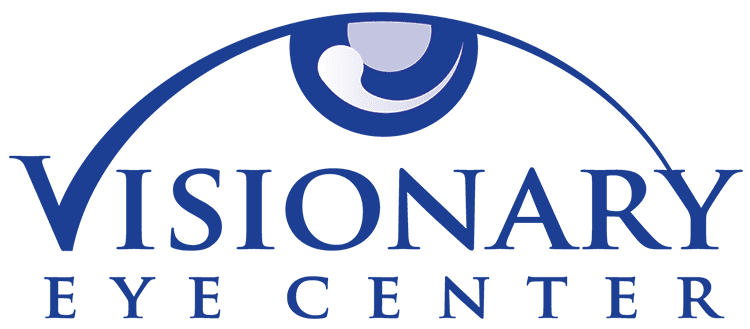 775.827.1100info@visionaryeyecenter.com8175 South Virginia Street Suite B-900
775.827.1100info@visionaryeyecenter.com8175 South Virginia Street Suite B-900